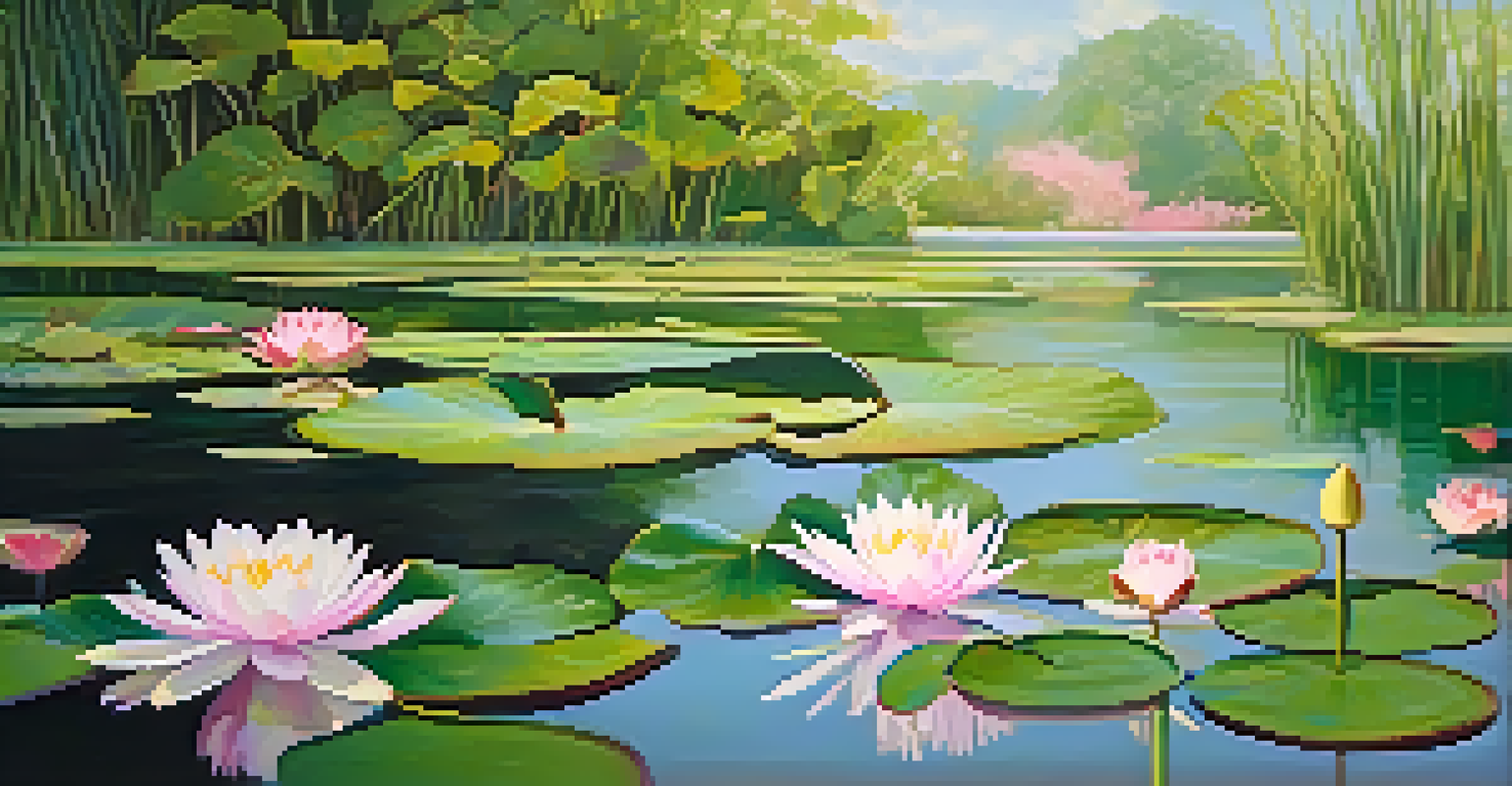Nature's Palette: The Influence of Plants in Impressionism

The Blossoming Relationship: Plants and Impressionism
Impressionism emerged in the late 19th century, and it was a movement that celebrated the beauty of the natural world. Artists like Claude Monet and Pierre-Auguste Renoir drew inspiration from their surroundings, particularly the vibrant flora that adorned their landscapes. The way light danced on petals and leaves became a central theme in their work, creating a connection between nature and emotion.
Nature always wears the colors of the spirit.
In many ways, plants served as both subjects and symbols in Impressionist pieces. They represented the fleeting moments of beauty that the artists sought to capture, embodying the essence of life itself. For instance, Monet’s famous 'Water Lilies' series showcases how he experimented with color and light to portray the ephemeral beauty of his garden, inviting viewers to experience nature in a new way.
This relationship between plants and Impressionism not only enhanced the visual appeal of the artwork but also allowed artists to express deeper feelings. By focusing on nature, they could convey themes of tranquility, renewal, and the passage of time, making their art resonate with audiences on a personal level.
Color Theory: How Plants Inspired Vibrant Palettes
One of the defining features of Impressionism is its bold use of color, which was heavily influenced by the natural world. Artists studied the colors found in gardens, forests, and fields, striving to replicate the vibrant hues they observed. This attention to color allowed them to create works that felt alive, bursting with the energy of the environment around them.

For instance, Van Gogh’s 'Sunflowers' is a striking example of how the colors of plants can evoke strong emotions. The yellows and greens are not just representations of the flowers; they convey a sense of warmth and joy, drawing viewers into the artist's emotional landscape. By using color in such a dynamic way, Impressionists transformed the canvas into a reflection of nature’s beauty.
Nature's Influence on Impressionism
Plants served as both subjects and symbols in Impressionist art, connecting the beauty of nature with deeper emotional themes.
Moreover, the use of complementary colors, inspired by the natural world, helped these artists achieve a sense of vibrancy and depth. This technique brought their paintings to life, making them not just visual experiences but also emotional journeys for the viewer.
The Garden as a Canvas: Monet's Influence
Claude Monet’s garden at Giverny is perhaps one of the most iconic examples of how plants shaped Impressionism. Monet meticulously cultivated a variety of flowers, trees, and water features, creating a living palette that inspired countless masterpieces. His garden wasn't just a backdrop; it was an integral part of his creative process.
The painter does not invent but reproduces the universe in his own way.
In 'The Japanese Bridge,' for example, Monet captures the lush greenery and blooming flowers that surrounded him. The way he painted the reflections of plants on the water illustrates his fascination with light and nature. Each brushstroke invites the viewer to experience the serenity and beauty of his garden firsthand.
Monet’s dedication to portraying his garden showcases how plants can influence not just subject matter, but also artistic technique. His willingness to paint the same scene at different times of day demonstrated the changing nature of light and color in relation to flora, solidifying his legacy in the art world.
Symbolism of Nature: Plants in Impressionist Themes
In Impressionism, plants often carry deeper meanings beyond their aesthetic appeal. Artists used flowers, trees, and gardens to symbolize various themes such as love, decay, or the passage of time. These layers of meaning add complexity to the seemingly simple depictions of nature.
For example, in Renoir’s 'Luncheon of the Boating Party,' the lush greenery surrounding the figures suggests a sense of leisure and joy, but it also hints at the fleeting nature of happiness. The vibrant plants serve as a reminder of life’s transience, urging viewers to cherish moments of joy.
Color and Light in Plant Depictions
Impressionist artists used bold colors and the interplay of light to create vibrant representations of plant life, evoking strong emotions.
This use of symbolism allows for a richer interpretation of Impressionist art, as it prompts viewers to look beyond the surface. By engaging with the underlying themes tied to plants, audiences can connect with the emotional experiences that these artists intended to convey.
The Role of Light: How Plants Reflect Impressionist Techniques
Light plays a crucial role in both Impressionism and the depiction of plants within this artistic movement. Artists experimented with how light interacts with foliage, flowers, and landscapes to create different moods and atmospheres. This exploration resulted in paintings that capture the essence of a moment in time, revealing the dynamic nature of light and its effect on color.
Monet’s 'Impression, Sunrise' exemplifies this interplay between light and nature. The way the sun’s rays illuminate the water and the surrounding flora creates a sense of tranquility and warmth. This technique not only brings the scene to life but also reinforces the idea that nature is ever-changing.
By focusing on light, Impressionists were able to convey the beauty of plants in a way that feels immediate and personal. This approach invites viewers to appreciate the subtle changes in their own environments, fostering a deeper connection to the natural world.
The Impact of Botany: Understanding Plant Life in Art
Impressionist artists often had a keen interest in botany, which influenced their ability to depict plants accurately. Many artists studied the shapes, colors, and growth patterns of various species, allowing them to create more lifelike representations in their work. This attention to detail not only enhanced realism but also enriched their artistic expression.
For instance, the intricate details of flowers in paintings like Monet's 'Irises' demonstrate a profound understanding of botany. The way he captures each petal and leaf allows viewers to appreciate the beauty of the flowers in a new light. This blend of art and science became a hallmark of Impressionism, setting it apart from previous artistic movements.
Legacy of Botanical Inspiration
The lasting impact of plants in Impressionism continues to inspire contemporary artists, emphasizing our connection to the natural world.
By integrating botanical knowledge into their work, Impressionists were able to celebrate the diversity of plant life. This appreciation for nature not only deepened their artistic practice but also encouraged a broader appreciation for the environment among their audiences.
Legacy of Plants in Impressionism: Lasting Inspirations
The influence of plants in Impressionism has left a lasting legacy in the art world. Many contemporary artists continue to draw inspiration from nature, echoing the techniques and themes established by their Impressionist predecessors. This ongoing dialogue with the natural world reminds us of our deep connection to the environment.
Moreover, Impressionism's focus on light, color, and organic forms has paved the way for various art movements that followed. The emphasis on capturing the fleeting beauty of nature resonates in modern art, encouraging artists to explore their surroundings creatively and authentically.

As we reflect on the vibrant world of plants in Impressionism, we recognize the importance of nature in shaping artistic expression. This legacy not only enriches our understanding of art but also invites us to appreciate the beauty that surrounds us every day.